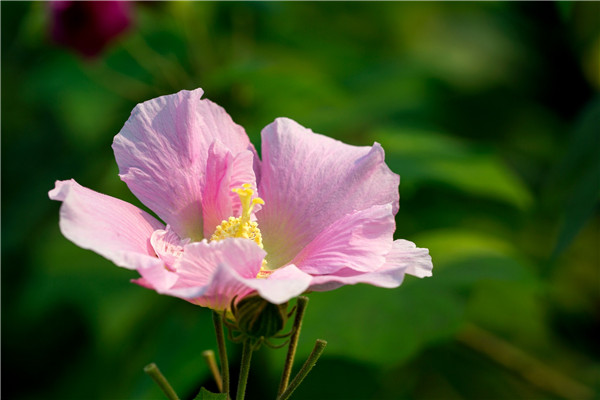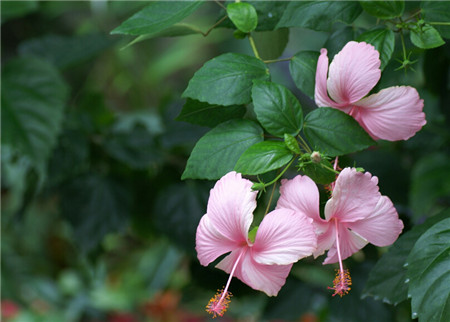Propagation methods of Hibiscus mandshurica
The propagation methods of hibiscus flower include cuttage, striping, plant division and so on.
The cuttage of the propagation method of hibiscus flower
The breeding methods of hibiscus flowers are mostly carried out in late autumn and early winter. after the plants have fallen leaves, cut the branches 5 to 10 centimeters from the ground and cut them into cuttings ranging from 10 centimeters to 15 centimeters. Every 50 cuttings are tied into bundles. The trenches (pits) are dug and stored in the leeward. The ditches are 40 centimeters deep and 50 centimeters wide. The bundled branches are arranged neatly vertically in the pit, covered with 10 to 20 centimeters of clean wet sand, and keep the sand moist afterwards. The following spring, its base has formed healing tissue, cutting is easy to survive. You can also cut branches and cuttings from March to April in spring, and cuttings should be selected-annual strong and full branches, each section 10 cm to 15 cm long, inserted in sand about 1 cm 2, in the northern area should be covered with plastic film to keep warm and humid, about 1 month can take root.
The crimping of the propagation method of hibiscus flower
From June to July, the outer branches of the plant were bent and pressed into the soil. Because it was easy to take root and did not need to be scratched, it took root about one month later, separated from the mother plant two months later, dug up the roots, and overwintered in the greenhouse or cellar. Planting the following spring.
The division of the propagation method of hibiscus flower
From February to March, the roots of the plant were dug out and separated, then planted in wet soil, compacted after planting, and watered for 5 days. It grew so fast that it could blossom in October.

Hibiscus cuttings
The most suitable time for cutting is in late autumn and early winter, waiting for hibiscus leaves to fall. It is best to choose the sturdy branches of the year, cut them all 5-10 cm from the ground, cut them into 10-15 cm cuttings, put them in bundles and store them in a trench in the leeward direction for storage, and cover them with clean wet sand to keep them moist. From February to March of the following year, take out the cuttings, untie the bundles, insert them into the seedbed one by one, do not exceed 10 centimeters on the ground, and cover with some grass, the survival rate is very high.
Hibiscus crimping
From June to July, bend the branch of Hibiscus hibiscus, be careful not to break it, and then press it into the soil. It will take root in a month, and it will be cut off from the mother plant in another month. Dig up the seeds by the roots and bury them in a greenhouse or cellar for the winter, so that they can be planted next spring.
Hibiscus hibiscus stand
It is best to do it before the plant sprouts in early spring. Prepare the soil to apply enough basic fertilizer in advance, dig up all the old plants, divide them into several plants according to the trend of their roots, and then plant them into the prepared soil immediately. It is best to water them a week later, and if they grow well, they can bloom that year.
Sowing Hibiscus hibiscus L.
From November to December, the ripe fruits are picked, dried and stored, and sown next spring. The seeds are buried deeply in the dug ditch and covered with soil. They can also be covered with grass, and they can emerge in half a month or so, and some of them can blossom in the same year.
In addition, the cilia on the hibiscus seeds can fall with the wind, so they can reproduce on the ground.
This is the end of the introduction on the breeding method of hibiscus. I hope it can help the flower friends who like to cultivate hibiscus.
Culture methods and matters needing attention of hibiscus flower
Selection of potted soil for the cultivation of Hibiscus hibiscus
Breeding hibiscus, flowerpots can choose larger porcelain flowerpots or vegetarian roast pots. The soil generally uses loose, fertile soil with good permeability, and the soil should be moist.
Water and fertilizer management
The growth of hibiscus needs sufficient water and fertilizer, needs to keep the soil moist, plants grow vigorously in spring, need a lot of watering, hot weather in summer also need more watering, into autumn watering will be reduced, appropriate water control. Watering must be carried out according to the water demand of the plant.
Fertilization should be reasonable, sufficient nutrients can make hibiscus grow better. Fertilizing before flowering, you can apply a little phosphate fertilizer, compared with a little water, you can make its flowering better and more beautiful.
Light
Hibiscus likes plenty of light, so it is necessary to ensure adequate light when breeding, especially in the autumn flowering period, if the light is not enough, it is easy to cause buds to fall. It is necessary to ensure sufficient light in winter, and it is best to shade the strong sunshine in summer.
Temperature
Hibiscus likes a warm growing environment and has a certain degree of cold resistance, but it is best to keep it indoors for overwintering in winter. Keeping the temperature above 10 ℃ can make it better to survive the winter.
Matters needing attention in the culture of hibiscus hibiscus
Hibiscus pruning is usually carried out after flowering. It can be trimmed into trees or shrubs, and attention should be paid to pruning dead branches and diseased branches so that the crown can be better ventilated and transparent.
Reproduction method
There are many propagation methods of hibiscus, such as cutting propagation, striping propagation, ramet propagation and so on.
Diseases and insect pests
In the process of hibiscus culture, there are aphids, red spiders, cinnabar spider mites, moths and other pests, as well as powdery mildew and other diseases, which need to be controlled in time.
- Prev

Planting conditions of Eucommia ulmoides
Planting conditions of Eucommia ulmoides
- Next

The habit and reproduction of Fusang flower
Fusang flower is native to East India and China's Guangdong, Guangxi, Taiwan, Fujian and Yunnan, Sichuan and other provinces. It is used to warm, very cold-resistant, winter requirements in 8 Mel 10 degrees Celsius winter, short-term low temperature is also easy to freeze, not easy to reproduce. Fusang is a strong positive tree species that likes the sun, and there is no need to hide and sprout in summer.
Related
- Fuxing push coffee new agricultural production and marketing class: lack of small-scale processing plants
- Jujube rice field leisure farm deep ploughing Yilan for five years to create a space for organic food and play
- Nongyu Farm-A trial of organic papaya for brave women with advanced technology
- Four points for attention in the prevention and control of diseases and insect pests of edible fungi
- How to add nutrient solution to Edible Fungi
- Is there any good way to control edible fungus mites?
- Open Inoculation Technology of Edible Fungi
- Is there any clever way to use fertilizer for edible fungus in winter?
- What agents are used to kill the pathogens of edible fungi in the mushroom shed?
- Rapid drying of Edible Fungi

